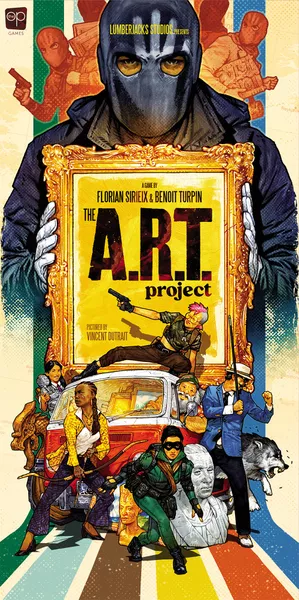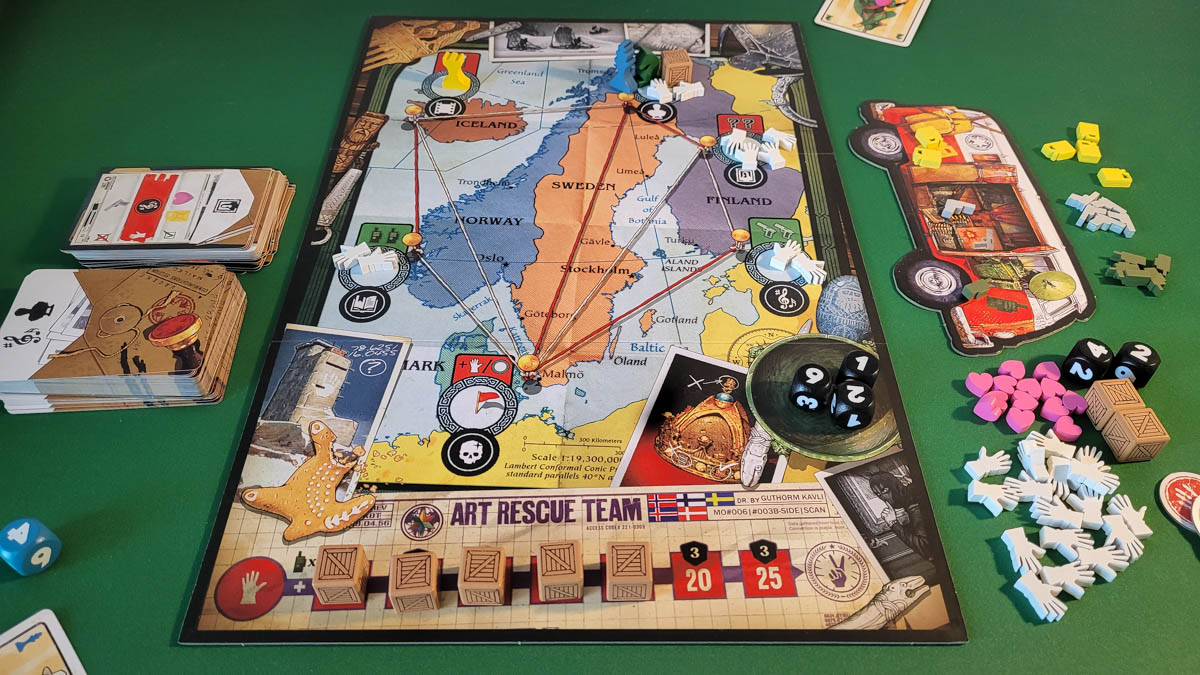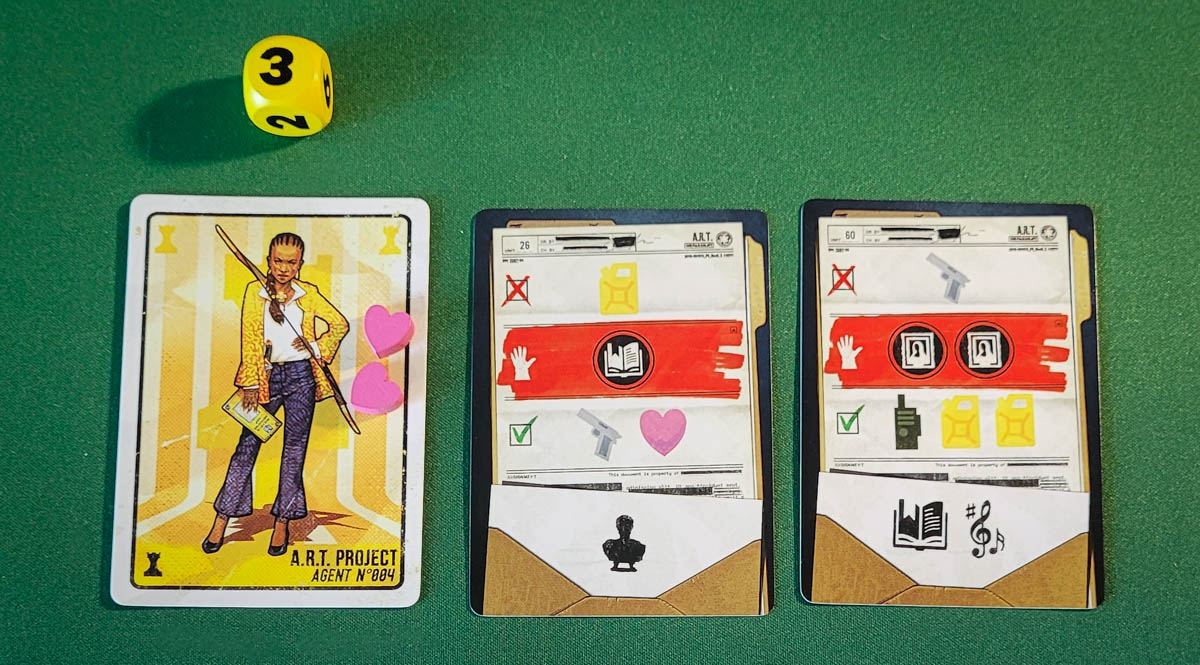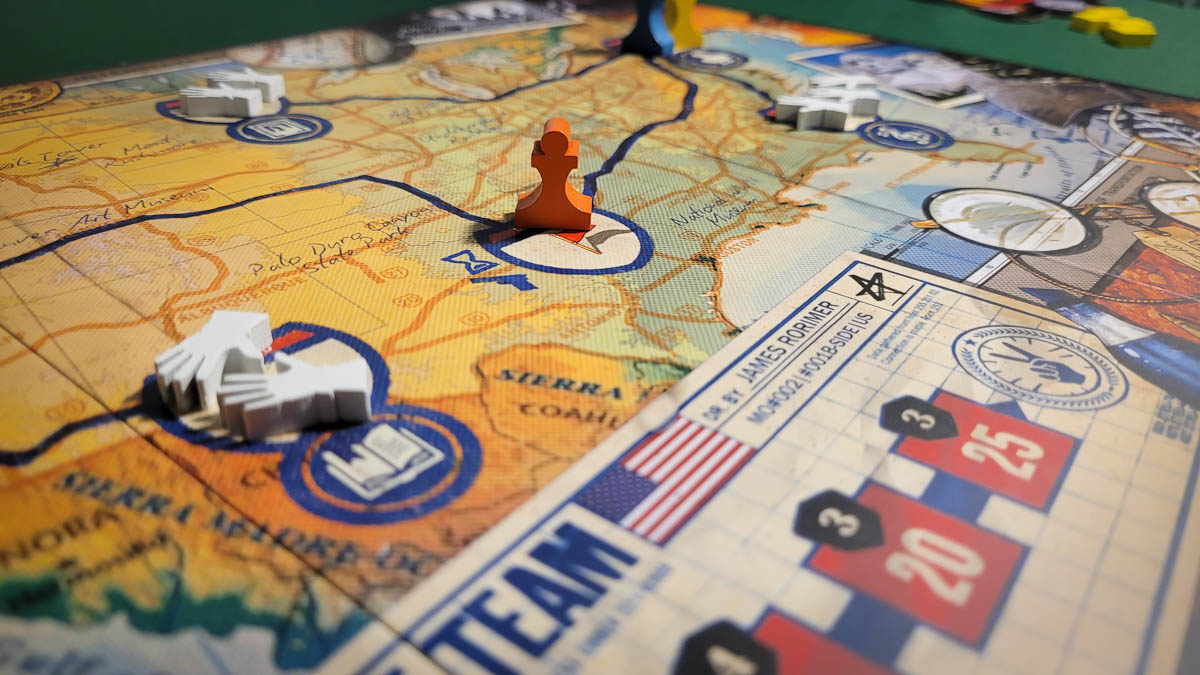The A.R.T. Project Review
Year: 2023 | Players: 1-6 | Minutes: 40 | Ages: 12+
This The A.R.T. Project review was made after playing the game six times. We were sent a copy of this game by the publisher in exchange for an honest review.
What is The A.R.T. Project?
The A.R.T. Project is a cooperative resource management game in which you attempt to retrieve stolen art from an evil organization.
The A.R.T. Project was designed by Florian Sirieix and Benoit Turpin, and it’s published by The Op.
Rules Overview
Your goal in The A.R.T. Project is to recover art pieces stolen by the White Hand organization. I’ll cover the rules for the starter map (Japan) here, but just know that the other five maps tweak the rules a bit.
The key to this game is cooperative resource management. You have to make sure you have enough gas to travel around the map, walkie-talkies to get new allies, guns to fight the White Hand agents, and health to stay alive. Health is the most important because it doubles as a wild resource.
Each round has four phases:
1. The Mission – Everyone draws two Mission cards and plays one (you can pay health tokens to draw extra cards). There’s no set turn order in this game, so you should openly discuss what you need and what you plan to do, but you can’t show your teammates your cards. Mission cards have you pay resources, place White Hand agents on the map, and then gain resources. After you play a card, you flip it over and it becomes a Clue card on the Clue Track. When there are three identical Clue symbols on the track, you discard those cards and place an art piece on the city with the matching symbol.
2. The Movement – Anyone can use gas tokens (or health tokens if there is no gas) to move around the map. If anyone lands in a city that has an art piece and no White Hand agents, the art piece is collected and added to the Art Piece Track.
3. The Fight – Anyone in a city with White Hand agents can fight them. Players use their dice and any Ally dice (you can buy Ally dice between any phase with walkie-talkies/health tokens) and you compare the total roll to the current strength of the White Hand. You can then use guns to add to your total and/or discard cards from the Clue Track to reroll dice. If you win the fight, you remove the agents and collect the art piece (if there is one). If you lose, one player loses a health token.
4. End of Round – If there are five or more White Hand agents in a city, that city becomes lost and you put a Lost Cities marker on it. You can’t move to/through a city with a Lost Cities marker, making the game much tougher to beat.
You’ll win the game if you collect all of the art pieces. You’ll lose if anyone loses their last health token, if you complete the last round without collecting all of the art pieces, if you need to place a White Hand agent and there are none left in the supply, or if you need to place a Lost Cities marker and there are none left in the supply.
Pros and Cons
Pros
- I’m a big fan of co-op games with variable turn orders, and I really like how it’s implemented in The A.R.T. Project. The first and second phases of each round require good communication so you can decide who should go when, making each successful round feel like a legit team win.
- I like that the health tokens double as wild resources. It makes resource management a bit more interesting and it’s always satisfying when someone has the extra heart token to help the team win a fight and maybe grab an art piece.
- The six maps really do give you six different ways to play the game. Each one requires a slightly different strategy, which gives the game a lot of replay value.
- I also like that the designers made it very easy to ramp up the difficulty. You just start with less health.
- This game is a good challenge, even at the lower difficulty levels. I’ve only won two of my six games so far, which is a good sign that it’ll continue to be tough even after 20+ plays.
- I think The A.R.T. Project looks fantastic on the table. Vincent Dutrait’s artwork is great, as always, and the pieces blend well with the board.
- The game is very easy to learn and teach. I’ve taught seven people how to play and within two rounds they all understood the turn structure.
Cons
- The characters not having unique powers feels like a missed opportunity. The game is well-balanced, so I get not wanting to mess with that, but I think most players prefer it when their characters can do something unique. I know I do!
- I enjoyed playing The A.R.T. Project as a two, three, and four-player game (three is the sweet spot), but it wasn’t as fun at five. It was playable, but it was pretty tough to keep track of all of the information players were sharing. I’m all for challenging games, but that was more frustrating than anything else.
- Quarterbacking can be a problem in this game. It’s pretty easy for someone to try to point their teammates in different directions, so some groups might want to avoid this one.
Final Thoughts
The A.R.T. Project definitely has a Pandemic vibe to it, but there are some differences that make it stand out. The variable turn order, the shared resources, and the different maps/scenarios all make it feel like a unique co-op game. It leans more abstract than thematic for me, but that’s totally fine since the gameplay is so solid and I really like the challenge it presents.
If you and your group generally enjoy playing light-medium cooperative games and this theme interests you, chances are you will get a kick out of The A.R.T Project. I especially recommend it to groups looking for a three-player cooperative game.
- Update: The A.R.T. Project was added to the Best Three-Player Games list!
The A.R.T. Project Links
BGG | Amazon | Miniature Market
Thanks for taking the time to read our The A.R.T. Project review!
Be sure to also take a look at our Best Cooperative Board Games list and the other board game rankings.
Subscribe to our newsletter if you want more co-op board game content sent right to your inbox!




